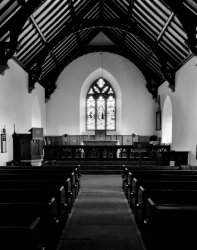-
Thank You For Visiting... Please Click Here and sign up to contribute and reply to posts and download the resources.
You are using an out of date browser. It may not display this or other websites correctly.
You should upgrade or use an alternative browser.
You should upgrade or use an alternative browser.
Penmon Chapel
- Thread starter Diz
- Start date
- Joined
- Aug 16, 2016
- Messages
- 62
I like this Diz it has dramatic contrast that suits the subject for me and I'm sure it looks good on the satin paper which is my favourite.
Richard
Richard
- Joined
- Aug 6, 2016
- Messages
- 621
I would imagine the darkroom print to be better than this, what I don't like here is the blacks, they are so strong they dominate, was there no shadow detail in the pews and the roof structures, perhaps I cannot see them on my device
Its down to the poor scanning Martin. On the print, there is just enough detail in the pews to stop them looking like a black mass. On the scan, detail is lost on the crowd control barrier in front of the alter.(Anyone know what its called?) Its there on the print. However, There is almost no detail in the roof beams. The lighting was directional from the front and low and not a lot bounced up. Being black didn't help either. I might try scanning the Negative and see what happens.
Cheers
Diz
Cheers
Diz
- Joined
- Aug 6, 2016
- Messages
- 621
Could be wrong but the "crowd barrier" is called the Transept
- Joined
- Aug 6, 2016
- Messages
- 387
Altar rail. Introduced by Archbishop Laud of questionable memory in the 17th century to keep the dogs away. Edit to add: Seriously!
- Joined
- Aug 9, 2016
- Messages
- 389
Altar rail. Introduced by Archbishop Laud of questionable memory in the 17th century to keep the dogs away. Edit to add: Seriously!
An amusing theory Stephen but according to Catholic literature:
"The Communion rail (sometimes called the altar rail) was introduced into Catholic churches in the ninth century. Its purpose was to set off the sanctuary from the rest of the church and to separate those whose duty it is to perform the sacramental action from those who form the celebrating congregation – a separation which was always taken for granted as essential to the Church’s constitution. This was in keeping with the ancient understanding of priest as the appointed intermediary between God and the people. The altar railing became better known as the Communion rail in the Middle Ages, when the faithful more widely began to receive Communion kneeling. This organic developed grew out of a pressing sense of reverence and humility toward the Eucharist."
... which is probably more in keeping methinks.
- Joined
- Aug 6, 2016
- Messages
- 387
An amusing theory Stephen but according to Catholic literature:
"The Communion rail (sometimes called the altar rail) was introduced into Catholic churches in the ninth century. Its purpose was to set off the sanctuary from the rest of the church and to separate those whose duty it is to perform the sacramental action from those who form the celebrating congregation – a separation which was always taken for granted as essential to the Church’s constitution. This was in keeping with the ancient understanding of priest as the appointed intermediary between God and the people. The altar railing became better known as the Communion rail in the Middle Ages, when the faithful more widely began to receive Communion kneeling. This organic developed grew out of a pressing sense of reverence and humility toward the Eucharist."
... which is probably more in keeping methinks.
In the 17th century, the Church of England was no longer part of the Roman Catholic church. Altar rails had been dispensed with on theological grounds, but Laud was high church and reintroduced them. I admit I was assuming that the chapel in the photograph wasn't a Roman Catholic one.
As far as I'm aware (because of the furore at the time amongst the Puritans) altar rails weren't found Church of England establishments until Laud reintroduced them.


